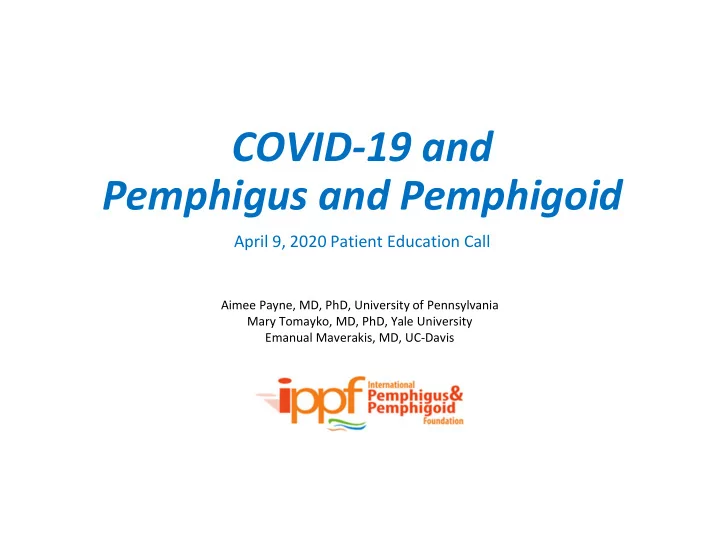

COVID-19 and Pemphigus and Pemphigoid April 9, 2020 Patient Education Call Aimee Payne, MD, PhD, University of Pennsylvania Mary Tomayko, MD, PhD, Yale University Emanual Maverakis, MD, UC-Davis
Overview Term Meaning Mary Tomayko, MD, PhD Background on the virus and symptoms Aimee Payne, MD, PhD Risk factors for more severe COVID-19 disease and current data on outcomes Emanual Maverakis, MD General advice on how to protect yourself during the COVID-19 outbreak Panel discussion Questions and answers
A basic primer on terminology Term Meaning Coronavirus A general term for the family of viruses that cause respiratory illness (SARS, MERS, SARS-CoV-2) SARS-CoV-2 The official name for the virus causing the global pandemic (severe acute respiratory syndrome coronavirus 2), also called “novel coronavirus” to distinguish from the SARS 2003 outbreak COVID-19 “coronavirus disease 2019” – the official name of the disease caused by SARS-Co-V2 https://www.cdc.gov/coronavirus/2019-ncov/faq.html#covid19-basics
How the novel coronavirus spreads • Person-to-person spread is the major transmission route • Respiratory droplets from sneezing, coughing, or talking (6 foot range) • Virus can be spread by asymptomatic carriers • Traces of virus can be found on solid surfaces such as doorknobs, elevator buttons, bathroom fixtures (toilet/faucet), office fixtures (phone/desk/keyboard) https://www.cdc.gov/coronavirus/2019-ncov/prevent-getting-sick/prevention.html
Disease symptoms (2-14 days after exposure) • Symptoms arise 2-14 days after exposure • Fever, cough, shortness of breath • Less common: loss of smell or taste, red eyes, diarrhea • Call your primary care doctor for guidance on testing if you have symptoms • Emergency symptoms warranting urgent evaluation (911 or ER) ⮚ Persistent chest pain/tightness, moderate to severe shortness of breath ⮚ Confusion, feeling “out of it”, severe dizziness or weakness ⮚ Congestive heart failure (sudden weight gain, leg swelling) https://www.cdc.gov/coronavirus/2019-ncov/faq.html#symptoms-testing
Individuals at higher risk for serious illness • Age > 65 • People who live in a nursing home or long-term care facility • Chronic lung disease, asthma • Serious heart conditions • Immunocompromised • Severe obesity (BMI > 40) • Diabetes • Chronic kidney disease undergoing dialysis • Chronic liver disease ⮚ Pemphigus and pemphigoid in and of itself, in the absence of any other risk factors, is not known to increase the risk of more serious COVID-19 illness https://www.cdc.gov/coronavirus/2019-ncov/faq.html#high-risk
COVID-19 outcomes Overall, 20% are hospitalized and 6% require ICU admission Number Overall cases 7% 72% 14% 6% (7162) (2692) (264) (4470) Preliminary Estimates of the Prevalence of Selected Underlying Health Conditions Among Patients with Coronavirus Disease 2019 — United States, February 12–March 28, 2020. Morb Mortal Wkly Rep 2020;69:382–386. DOI: http://dx.doi.org/10.15585/mmwr.mm6913e2 (Table 1 has been modified to simplify)
40% of immunocompromised cases are hospitalized, 16% require ICU (~same risk as heart/lung/kidney disease, diabetes, obesity) Overall cases 7% 72% 14% 6% (7162) Heart/lung/kidney disease, (2692) asthma, diabetes, obesity 27% 13% 8% 52% (264) 7% 53% 24% 16% (4470) 7% 84% 7% 2% Preliminary Estimates of the Prevalence of Selected Underlying Health Conditions Among Patients with Coronavirus Disease 2019 — United States, February 12–March 28, 2020. Morb Mortal Wkly Rep 2020;69:382–386. DOI: http://dx.doi.org/10.15585/mmwr.mm6913e2 (Table 1 has been modified to simplify)
Being immunocompromised increases the risk of hospitalization by 3x and ICU admission by 8x compared to those without risk factors Overall cases 7% 72% 14% 6% (7162) Heart/lung/kidney disease, (2692) asthma, diabetes, obesity 27% 13% 8% 52% (264) 7% 53% 24% 16% (4470) 7% 84% 7% 2% *Caveat: Due to limited test availability, cases with mild or no symptoms are likely not captured in these statistics Preliminary Estimates of the Prevalence of Selected Underlying Health Conditions Among Patients with Coronavirus Disease 2019 — United States, February 12–March 28, 2020. Morb Mortal Wkly Rep 2020;69:382–386. DOI: http://dx.doi.org/10.15585/mmwr.mm6913e2 (Table 1 has been modified to simplify)
How to protect yourself from infection • Currently, stay at home to the extent possible • Wear a cloth face cover when you go out for food or other necessities (more on this on the next slide) • If you do go out, stay 6 feet away from people you do not live with • Avoid non-essential travel and mass transit • Wash your hands with soap and water for at least 20 seconds after returning home • If soap and water are not available, use hand sanitizer with >60% alcohol • Avoid touching your eyes/nose/mouth with unwashed hands https://www.cdc.gov/coronavirus/2019-ncov/prevent-getting-sick/prevention.html
Guidances on masks • The CDC has not recommended medical-grade masks for the general public due to shortages • On 4/3/20, the CDC recommended a cloth face covering for the general public to reduce your ability to spread and also inhale respiratory droplets (instructions posted online) • Face coverings should not be used for those under age 2 or those who can’t remove the mask without assistance • Don’t forget hand-washing and physical distancing in addition • “Perfect is the enemy of good” – this strategy conserves precious medical resources and also reduces risk of spread among the general public https://www.cdc.gov/coronavirus/2019-ncov/prevent-getting-sick/diy-cloth-face-coverings.html
Balancing P/P therapy with risk of COVID-19 • The goal is to maintain disease control on the least amount of immunosuppression, and avoid a disease flare that may require hospitalization • Topical steroids, doxycycline, dapsone likely don’t affect risk of serious disease (unless greater than 20 g topical steroids are used daily) • Immunosuppressives such as oral steroids (particularly greater than 20 mg daily), mycophenolate, azathioprine, methotrexate, cyclophosphamide, cyclosporine, and rituximab may increase your risk of infection and more severe disease • An advantage of IVIg is that it is not immunosuppressive and may be able to be given through home infusion ⮚ Speak with your doctor if you have concerns about your treatment regimen https://www.cdc.gov/coronavirus/2019-ncov/faq.html#high-risk
Recommend
More recommend